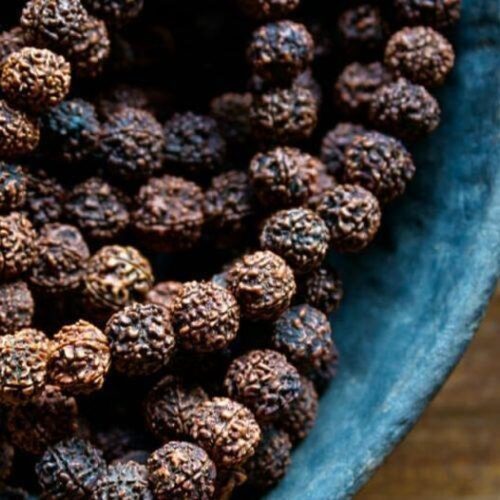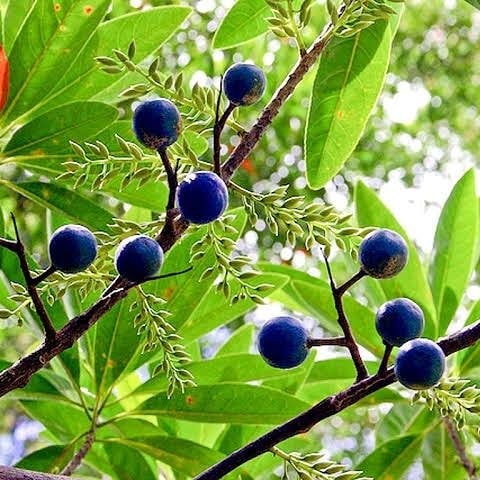Rudraksha Tree Care is not difficult you can grow this auspicious plant in your home with the help of this guide.
If you live in a warm climate, you can grow the Rudraksha tree. It takes some time for the seeds to start developing, but eventually, you’ll have a small tree that you can keep in a pot or plant in the ground. Just make sure to give it the right conditions, and in about 7 years, it should start producing fruits.
Common Names: Rudraksha tree, Utrasum Bead Tree, Blue Marble Tree
USDA Zones: 10-11
Read: ‘Grey Owl’ Juniper Care and Growing Guide
Rudraksha Tree Information

Native to the Himalayas to South East Asia, New Guinea, Hawaii, and Indonesia, the Rudraksha tree is also known as Utrasum Bead Tree, it is a large evergreen tree popular for its blue seeds. It has shiny, green, oblong leaves and a rough, grayish-white trunk. As the tree grows, it often has roots spreading along the ground. In spring, it produces small white flowers followed by acidic-tasting, round or oval, violet or blue fruits with hard seeds, known as blueberry beads. It can reach up to 50-80 feet tall.
Rudraksha beads are considered sacred in Hinduism and are believed to be tears shed by Lord Shiva for humanity. They are worn on wrists, forearms, or necks and are thought to bring psychic powers, good health, and prosperity.
Additionally, Rudraksha is used in traditional medicine for treating conditions like hypertension, anxiety, epilepsy, migraine, depression, palpitation, nerve pain, asthma, arthritis, and liver disease. The tree is also valued for its fast-growing timber.
Read: Pacific Sunset Maple Tree Care and Growing Info
How to Propagate a Rudraksha Tree
- You can get rudraksha seeds online or use fresh ones from a tree you already have.
- Soak the seeds in a bowl filled with lukewarm water for 48 hours. After 2 days, pour out the water and dry the seeds.
- Use a hammer to break the outer shells of the seeds and help them start growing.
- If you don’t want to break the seeds, they will still grow but it will take longer. If a seed doesn’t break, you can try putting a nail on the intersection and hitting it with a hammer.
- Take a 6-inch pot and fill it with a mix of peat moss and perlite. Make sure the mix is 60% peat moss and 40% perlite, and mix them well. Pour this mix into the pot and make the surface even.
- Make sure they’re spaced 1 to 2 inches apart so they have enough room and don’t compete for nutrients.
- Water the plant gently, and avoid overwatering at any cost as it can rot your tree.
- Place the pot in a place that’s warmer than 50 °F (10 °C) and gets about 4 hours of shade. If the plant is indoors, keep it close to a south-facing window for indirect sunlight.
- Outside, place it under a shady tree if it’s not colder than 50 °F (10 °C). Rudraksha seeds won’t start growing if it’s too cold.
- Check the pot every day for tiny green sprouts or leaves, which should show up in about 1 to 2 months.
- Keep watering them regularly as they grow. Sometimes, it might take up to a year for the seeds to sprout, especially if the temperature changes a lot where you are. Not all the seeds may sprout, and that’s okay.
When to Transplant
Allow the young plants to grow until they’re about 3 feet tall. Keep watering them and keep them in a sunny spot every day. After about 1 to 2 years, when they are at least 3 feet tall, you can take them out of the pot to transplant.
Where to Transplant the Tree
Pick an empty spot in your yard that’s 10 feet by 10 feet. Make sure there’s enough space around the young tree for its roots and branches to spread out. Check that there are no other plants nearby, as they might take away the nutrients the tree needs. Rudraksha trees can grow tall, up to 80 feet, so make sure there are no utility lines or other branches in the way.
TIP: If you don’t have enough yard space or if it gets too cold (below 50 °F or 10 °C), you can use a larger pot that’s twice as wide and twice as deep as the first pot.
Ideal Growing Conditions for Rudraksha Tree

Location
Grow the rudraksha tree where it gets at least 4 hours of shade. It’s good to plant it near a big tree or on the south side of your home for more shade. If you can’t find a shaded area, your tree might not grow as well because it usually does better under the cover of other trees in its natural habitat.
Soil
Grow this tree in well-draining soil. For optimal growth, use a mix of coco peat and perlite.
Water
Water the soil when it’s dry 3 inches below the surface. Check the soil by putting your finger on it. If it’s still wet, let it dry. Otherwise, use a watering can to water around the trunk until the soil is wet 6 inches down. Be cautious not to overwater to avoid root rot.
Read: Fireglow Japanese Maple Care
Rudraksha Tree Care

Fertilizer
Apply 1/3 oz (9.4 g) of 10-10-10 NPK fertilizer to the soil every spring. Use the measuring cup that comes with the fertilizer. Sprinkle the fertilizer around the tree in early spring, making sure it doesn’t touch the trunk. Water the soil right away so the fertilizer soaks in and nourishes the roots.
Avoid letting the fertilizer touch the tree trunk as it may cause burn marks or death. Be cautious not to over-fertilize, as it can impact the soil’s chemistry and harm the tree.
Pruning
Cut off diseased and damaged branches from the tree. Look for yellow or brown leaves. Use hand pruners to make a flush cut where the branch connects to the main trunk. Keep cutting off any other diseased branches.
Avoid removing more than a third of the tree’s growth as it might cause the tree to die. If the tree gets bigger, use a tree saw to cut through branches, as close to the trunk connection as possible.
Weeding
Remove weeds when you see them around the tree. Check for weeds weekly near the base of the trunk. Grab the weeds close to the roots and pull them straight out. Use a trowel to carefully dig out roots.
You can put a 2-inch layer of mulch around the tree to stop weed growth and help the soil hold moisture, reducing the need for frequent watering.
Pests and Diseases
Keep the rudraksha plant free from pests by using neem spray if needed. To prevent diseases like root rot and fungal infections, avoid both overwatering and underwatering the plant.
Harvesting
Harvest fruit from the tree after 7 years of growth. Look for round, blue fruits, called blueberry beads, in late summer or fall. Although the fruits taste bitter, people often use the large seeds inside for making holy necklaces. To get the seeds, remove the flesh from the fruit and rinse the seeds in clean water.
You can plant the seeds or use them to make rudraksha beads.
Read: Tips to Grow River Tamarind
Can we grow Rudraksha tree at home as per Vastu?
You can plant a Rudraksha tree in your home garden, as it is auspicious. According to Vastu Shastra, having a Rudraksha tree near the house can help keep negative energies away. Grow the Rudraksha tree in a place with enough sunlight.
Benefits of Rudraksha Tree
In addition to its spiritual significance, the rudraksha tree possesses various medicinal properties.
- The leaves have antibacterial and anti-inflammatory qualities, historically been used to address wounds, migraines, epilepsy, and headaches.
- According to Ayurveda, the nuts function as natural blood purifiers.
- Research suggests that rudraksha may help control conditions such as blood pressure, asthma, mental disorders, diabetes, gynecological issues, and neurological disorders.
- Keeping the beads close to the body is believed to reduce stress and anxiety while wearing them is thought to attract positive energy and cool the body’s temperature.



